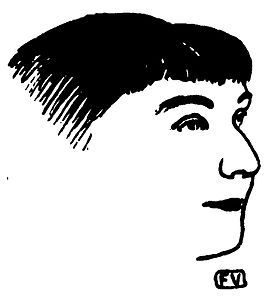Wikipedia:Visual representation of women
This is an essay. It contains the advice or opinions of one or more Wikipedia contributors. This page is not an encyclopedia article, nor is it one of Wikipedia's policies or guidelines, as it has not been thoroughly vetted by the community. Some essays represent widespread norms; others only represent minority viewpoints. |

Gender balance, diversity and fairness are values that Wikipedia promotes in the interests of all editors and readers. Even though, the Gender bias on Wikipedia, also known as the Gendergap, is a persistent reality. It refers to criticism towards the nature and quantity of content biased on the online encyclopedia due to a dominant majority of male editors. In April 2011, the Wikimedia Foundation conducted its first survey, revealing that less than 13% of its contributors are female.[1] In the last years, efforts to increase female editorship are to be underlined such as dedicated edit-a-thons to increase the coverage of women's topics in Wikipedia and to encourage more women to edit Wikipedia.
To go further and approach the topic in a diverse way, this essay page points at the lack of images on Wikipedia when it comes to represent women. This absence of visual culture (portraits, self-portraits, drawings, etc.) reinforces the fact that female personalities are nor strongly present neither portrayed.
This page may help to consider the phenomenon and reflect on new type of events and contributions on Wikipedia, oriented in the production of a visual culture around female personalities, and more widely women on Wikipedia.
Research Findings
[edit]Infoboxes
[edit]Infoboxes are usually used to improve the appearance of an article on Wikipedia. Its template offers the possibility to link an image previously uploaded and licensed on Wikimedia Commons.
To improve an article of a personality who has not entered yet the Public Domain, Wikipedia editors, if they are not granted permission by copyright holders, may face issues when trying to provide an image. The options to be considered in the situation are the following : to request permission to copyright holders of the studied personality or to request permission to copyright holders of the photographer, author of the photography of the studied personality. In some cases, self-portrait can be used and placed in the infobox, if they assure physical likeness.
When these conditions are not to be fulfilled, as encountered on some Wikipedia articles, a diverse way is to produce a personal work.
Wikimedia Commons
[edit]Existing categories and sub-categories on Wikimedia Commons :
- http://commons.wikimedia.org/wiki/Category:Portrait_drawings
- http://commons.wikimedia.org/wiki/Category:Portrait_drawings_of_women
- http://commons.wikimedia.org/wiki/Category:Portrait_drawings_of_men
- http://commons.wikimedia.org/wiki/Category:Portraits_of_women
- http://commons.wikimedia.org/wiki/Category:Portraits_of_men
Visual culture of portraits on Wikipedia
[edit]- Portraits & techniques
-
Rachilde by Felix Valloton, woodcut.
-
Bolaño by Farisori, stencil.
-
Ada Lovelace by Ada Initiative, illustration.
-
Patti Smith by Sardine & Tobleroni, painting.
Call for visual contributions
[edit]
In the online communities of projects such as Wikipedia or OpenStreetMap, an edit-a-thon is a design sprint-like event where editors edit and improve a specific topic or type of content, typically including basic editing training for new editors.
As a way to enrich articles about women with visual contributions, graphic design oriented events could be organized. Editing would leave place in first to creation of visual works. Those creations would be digitized, uploaded, informed and licensed on Wikimedia Commons before being edited on Wikipedia.
Diverse techniques are to be considered :
Addressing the non-neutrality of representations
[edit]No representation is “neutral”. It could be interesting to add details about how a picture is made in the description of the image itself.

See also
[edit]- Wikipedia:Meetup/justfortherecord, Just For The Record is a project addressing how gender is represented in new media and writing/publishing tools like Wikipedia, and what influence this has on the way history is recorded.
- Wikipedia:Meetup/ArtAndFeminism, Art+Feminism is a rhizomatic campaign to improve coverage of women and the arts on Wikipedia, and to encourage female editorship.
- Ada Lovelace Day/Women in STEM,"Ada Lovelace Day" is an annual event celebrated in mid-October[90] whose goal is to "... raise the profile of women in science, technology, engineering and maths," and to "create new role models for girls and women" in these fields.
- WP:WAW, an essay to bring attention on writing about women on Wikipedia to make sure the content and titles do not inadvertently use sexist language or promote sexist stereotypes.
References
[edit]- ^ Glott, Ruediger; et al. (15 March 2010). "Wikipedia Survey – Overview of Results" (PDF). United Nations University.




